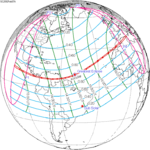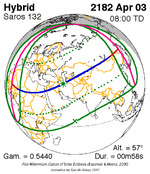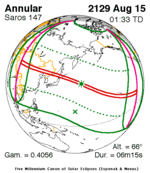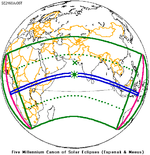Solar eclipse of November 23, 1965
| Solar eclipse of November 23, 1965 | |
|---|---|
| Type of eclipse | |
| Nature | Annular |
| Gamma | 0.3906 |
| Magnitude | 0.9656 |
| Maximum eclipse | |
| Duration | 242 s (4 min 2 s) |
| Coordinates | 1°42′N 119°48′E / 1.7°N 119.8°E |
| Max. width of band | 134 km (83 mi) |
| Times (UTC) | |
| Greatest eclipse | 4:14:51 |
| References | |
| Saros | 132 (43 of 71) |
| Catalog # (SE5000) | 9433 |
An annular solar eclipse occurred at the Moon's descending node of orbit on Tuesday, November 23, 1965,[1] with a magnitude of 0.9656. A solar eclipse occurs when the Moon passes between Earth and the Sun, thereby totally or partly obscuring the image of the Sun for a viewer on Earth. An annular solar eclipse occurs when the Moon's apparent diameter is smaller than the Sun's, blocking most of the Sun's light and causing the Sun to look like an annulus (ring). An annular eclipse appears as a partial eclipse over a region of the Earth thousands of kilometres wide. Occurring about 6.3 days before apogee (on November 29, 1965, at 12:00 UTC), the Moon's apparent diameter was smaller.[2]
Annularity was visible from the Soviet Union (today's eastern Turkmenistan, southern Uzbekistan and southwestern Tajikistan), Afghanistan, Pakistan, India, China, Nepal (including the capital city Kathmandu), southwestern Sikkim (now merged with India), Burma, southwestern tip of Sainyabuli Province in Laos, Cambodia, South Vietnam (now belonging to Vietnam), Spratly Islands, Brunei, Malaysia, Indonesia, the Territory of Papua New Guinea (today's Papua New Guinea), and Gilbert and Ellice Islands (the part now belonging to Kiribati). 8 of the 14 eight-thousanders—Dhaulagiri, Annapurna, Manaslu, Shishapangma, Cho Oyu, Everest, Lhotse and Makalu, as well as the highest peak of Oceania, Puncak Jaya, lie in the path of annularity. A partial eclipse was visible for most of Asia, Australia, and Oceania.
Observation
[edit]An observation team of the Lockheed Corporation and the United States Air Force observed the annular eclipse near Chiang Mai, Thailand's second largest city. They calculated the relationship between the angular diameters of the moon and the sun during annularity, and the flattening of the moon based on the results.[3]
Eclipse details
[edit]Shown below are two tables displaying details about this particular solar eclipse. The first table outlines times at which the moon's penumbra or umbra attains the specific parameter, and the second table describes various other parameters pertaining to this eclipse.[4]
| Event | Time (UTC) |
|---|---|
| First Penumbral External Contact | 1965 November 23 at 01:24:37.4 UTC |
| First Umbral External Contact | 1965 November 23 at 02:29:29.3 UTC |
| First Central Line | 1965 November 23 at 02:31:10.9 UTC |
| First Umbral Internal Contact | 1965 November 23 at 02:32:52.8 UTC |
| First Penumbral Internal Contact | 1965 November 23 at 03:52:46.9 UTC |
| Equatorial Conjunction | 1965 November 23 at 04:00:47.7 UTC |
| Ecliptic Conjunction | 1965 November 23 at 04:10:27.3 UTC |
| Greatest Eclipse | 1965 November 23 at 04:14:51.0 UTC |
| Last Penumbral Internal Contact | 1965 November 23 at 04:37:14.5 UTC |
| Greatest Duration | 1965 November 23 at 04:40:27.4 UTC |
| Last Umbral Internal Contact | 1965 November 23 at 05:56:56.0 UTC |
| Last Central Line | 1965 November 23 at 05:58:40.8 UTC |
| Last Umbral External Contact | 1965 November 23 at 06:00:25.4 UTC |
| Last Penumbral External Contact | 1965 November 23 at 07:05:17.0 UTC |
| Parameter | Value |
|---|---|
| Eclipse Magnitude | 0.96561 |
| Eclipse Obscuration | 0.93240 |
| Gamma | 0.39061 |
| Sun Right Ascension | 15h54m02.2s |
| Sun Declination | -20°17'39.6" |
| Sun Semi-Diameter | 16'11.9" |
| Sun Equatorial Horizontal Parallax | 08.9" |
| Moon Right Ascension | 15h54m30.7s |
| Moon Declination | -19°56'39.6" |
| Moon Semi-Diameter | 15'24.9" |
| Moon Equatorial Horizontal Parallax | 0°56'34.5" |
| ΔT | 36.5 s |
Eclipse season
[edit]This eclipse is part of an eclipse season, a period, roughly every six months, when eclipses occur. Only two (or occasionally three) eclipse seasons occur each year, and each season lasts about 35 days and repeats just short of six months (173 days) later; thus two full eclipse seasons always occur each year. Either two or three eclipses happen each eclipse season. In the sequence below, each eclipse is separated by a fortnight.
| November 23 Descending node (new moon) |
December 8 Ascending node (full moon) |
|---|---|
 |

|
| Annular solar eclipse Solar Saros 132 |
Penumbral lunar eclipse Lunar Saros 144 |
Related eclipses
[edit]Eclipses in 1965
[edit]- A total solar eclipse on May 30.
- A partial lunar eclipse on June 14.
- An annular solar eclipse on November 23.
- A penumbral lunar eclipse on December 8.
Metonic
[edit]- Preceded by: Solar eclipse of February 5, 1962
- Followed by: Solar eclipse of September 11, 1969
Tzolkinex
[edit]- Preceded by: Solar eclipse of October 12, 1958
- Followed by: Solar eclipse of January 4, 1973
Half-Saros
[edit]- Preceded by: Lunar eclipse of November 18, 1956
- Followed by: Lunar eclipse of November 29, 1974
Tritos
[edit]- Preceded by: Solar eclipse of December 25, 1954
- Followed by: Solar eclipse of October 23, 1976
Solar Saros 132
[edit]- Preceded by: Solar eclipse of November 12, 1947
- Followed by: Solar eclipse of December 4, 1983
Inex
[edit]- Preceded by: Solar eclipse of December 13, 1936
- Followed by: Solar eclipse of November 3, 1994
Triad
[edit]- Preceded by: Solar eclipse of January 22, 1879
- Followed by: Solar eclipse of September 22, 2052
Solar eclipses of 1964–1967
[edit]This eclipse is a member of a semester series. An eclipse in a semester series of solar eclipses repeats approximately every 177 days and 4 hours (a semester) at alternating nodes of the Moon's orbit.[5]
The partial solar eclipses on January 14, 1964 and July 9, 1964 occur in the previous lunar year eclipse set.
| Solar eclipse series sets from 1964 to 1967 | ||||||
|---|---|---|---|---|---|---|
| Ascending node | Descending node | |||||
| Saros | Map | Gamma | Saros | Map | Gamma | |
| 117 | June 10, 1964 Partial |
−1.1393 | 122 | December 4, 1964 Partial |
1.1193 | |
| 127 | May 30, 1965 Total |
−0.4225 | 132 | November 23, 1965 Annular |
0.3906 | |
| 137 | May 20, 1966 Annular |
0.3467 | 142 | November 12, 1966 Total |
−0.33 | |
| 147 | May 9, 1967 Partial |
1.1422 | 152 | November 2, 1967 Total (non-central) |
1.0007 | |
Saros 132
[edit]This eclipse is a part of Saros series 132, repeating every 18 years, 11 days, and containing 71 events. The series started with a partial solar eclipse on August 13, 1208. It contains annular eclipses from March 17, 1569 through March 12, 2146; hybrid eclipses on March 23, 2164 and April 3, 2182; and total eclipses from April 14, 2200 through June 19, 2308. The series ends at member 71 as a partial eclipse on September 25, 2470. Its eclipses are tabulated in three columns; every third eclipse in the same column is one exeligmos apart, so they all cast shadows over approximately the same parts of the Earth.
The longest duration of annularity was produced by member 25 at 6 minutes, 56 seconds on May 9, 1641, and the longest duration of totality will be produced by member 61 at 2 minutes, 14 seconds on June 8, 2290. All eclipses in this series occur at the Moon’s descending node of orbit.[6]
| Series members 34–56 occur between 1801 and 2200: | |||
|---|---|---|---|
| 34 | 35 | 36 | |
 August 17, 1803 |
 August 27, 1821 |
 September 7, 1839 | |
| 37 | 38 | 39 | |
 September 18, 1857 |
 September 29, 1875 |
 October 9, 1893 | |
| 40 | 41 | 42 | |
 October 22, 1911 |
 November 1, 1929 |
 November 12, 1947 | |
| 43 | 44 | 45 | |
 November 23, 1965 |
 December 4, 1983 |
 December 14, 2001 | |
| 46 | 47 | 48 | |
 December 26, 2019 |
 January 5, 2038 |
 January 16, 2056 | |
| 49 | 50 | 51 | |
 January 27, 2074 |
 February 7, 2092 |
 February 18, 2110 | |
| 52 | 53 | 54 | |
 March 1, 2128 |
 March 12, 2146 |
 March 23, 2164 | |
| 55 | 56 | ||
 April 3, 2182 |
 April 14, 2200 | ||
Metonic series
[edit]The metonic series repeats eclipses every 19 years (6939.69 days), lasting about 5 cycles. Eclipses occur in nearly the same calendar date. In addition, the octon subseries repeats 1/5 of that or every 3.8 years (1387.94 days). All eclipses in this table occur at the Moon's descending node.
| 22 eclipse events between September 12, 1931 and July 1, 2011 | ||||
|---|---|---|---|---|
| September 11–12 | June 30–July 1 | April 17–19 | February 4–5 | November 22–23 |
| 114 | 116 | 118 | 120 | 122 |
 September 12, 1931 |
 June 30, 1935 |
 April 19, 1939 |
 February 4, 1943 |
 November 23, 1946 |
| 124 | 126 | 128 | 130 | 132 |
 September 12, 1950 |
 June 30, 1954 |
 April 19, 1958 |
 February 5, 1962 |
 November 23, 1965 |
| 134 | 136 | 138 | 140 | 142 |
 September 11, 1969 |
 June 30, 1973 |
 April 18, 1977 |
 February 4, 1981 |
 November 22, 1984 |
| 144 | 146 | 148 | 150 | 152 |
 September 11, 1988 |
 June 30, 1992 |
 April 17, 1996 |
 February 5, 2000 |
 November 23, 2003 |
| 154 | 156 | |||
 September 11, 2007 |
 July 1, 2011 | |||
Tritos series
[edit]This eclipse is a part of a tritos cycle, repeating at alternating nodes every 135 synodic months (≈ 3986.63 days, or 11 years minus 1 month). Their appearance and longitude are irregular due to a lack of synchronization with the anomalistic month (period of perigee), but groupings of 3 tritos cycles (≈ 33 years minus 3 months) come close (≈ 434.044 anomalistic months), so eclipses are similar in these groupings.
| Series members between 1801 and 2200 | ||||
|---|---|---|---|---|
 March 4, 1802 (Saros 117) |
 February 1, 1813 (Saros 118) |
 January 1, 1824 (Saros 119) |
 November 30, 1834 (Saros 120) |
 October 30, 1845 (Saros 121) |
 September 29, 1856 (Saros 122) |
 August 29, 1867 (Saros 123) |
 July 29, 1878 (Saros 124) |
 June 28, 1889 (Saros 125) |
 May 28, 1900 (Saros 126) |
 April 28, 1911 (Saros 127) |
 March 28, 1922 (Saros 128) |
 February 24, 1933 (Saros 129) |
 January 25, 1944 (Saros 130) |
 December 25, 1954 (Saros 131) |
 November 23, 1965 (Saros 132) |
 October 23, 1976 (Saros 133) |
 September 23, 1987 (Saros 134) |
 August 22, 1998 (Saros 135) |
 July 22, 2009 (Saros 136) |
 June 21, 2020 (Saros 137) |
 May 21, 2031 (Saros 138) |
 April 20, 2042 (Saros 139) |
 March 20, 2053 (Saros 140) |
 February 17, 2064 (Saros 141) |
 January 16, 2075 (Saros 142) |
 December 16, 2085 (Saros 143) |
 November 15, 2096 (Saros 144) |
 October 16, 2107 (Saros 145) |
 September 15, 2118 (Saros 146) |
 August 15, 2129 (Saros 147) |
 July 14, 2140 (Saros 148) |
 June 14, 2151 (Saros 149) |
 May 14, 2162 (Saros 150) |
 April 12, 2173 (Saros 151) |
 March 12, 2184 (Saros 152) |
 February 10, 2195 (Saros 153) | |||
Inex series
[edit]This eclipse is a part of the long period inex cycle, repeating at alternating nodes, every 358 synodic months (≈ 10,571.95 days, or 29 years minus 20 days). Their appearance and longitude are irregular due to a lack of synchronization with the anomalistic month (period of perigee). However, groupings of 3 inex cycles (≈ 87 years minus 2 months) comes close (≈ 1,151.02 anomalistic months), so eclipses are similar in these groupings.
| Series members between 1801 and 2200 | ||
|---|---|---|
 March 4, 1821 (Saros 127) |
 February 12, 1850 (Saros 128) |
 January 22, 1879 (Saros 129) |
 January 3, 1908 (Saros 130) |
 December 13, 1936 (Saros 131) |
 November 23, 1965 (Saros 132) |
 November 3, 1994 (Saros 133) |
 October 14, 2023 (Saros 134) |
 September 22, 2052 (Saros 135) |
 September 3, 2081 (Saros 136) |
 August 15, 2110 (Saros 137) |
 July 25, 2139 (Saros 138) |
 July 5, 2168 (Saros 139) |
 June 15, 2197 (Saros 140) |
|
Notes
[edit]- ^ "November 23, 1965 Annular Solar Eclipse". timeanddate. Retrieved 7 August 2024.
- ^ "Moon Distances for London, United Kingdom, England". timeanddate. Retrieved 7 August 2024.
- ^ Stoddard, L. G. ; Carson, D. G. (January 1967). SELENODETIC MEASUREMENTS FROM THE ANNULAR ECLIPSE OF 23 NOVEMBER 1965. Air Force Cambridge Research Laboratories. Archived from the original on 21 April 2016.
{{cite book}}: CS1 maint: multiple names: authors list (link) - ^ "Annular Solar Eclipse of 1965 Nov 23". EclipseWise.com. Retrieved 7 August 2024.
- ^ van Gent, R.H. "Solar- and Lunar-Eclipse Predictions from Antiquity to the Present". A Catalogue of Eclipse Cycles. Utrecht University. Retrieved 6 October 2018.
- ^ "NASA - Catalog of Solar Eclipses of Saros 132". eclipse.gsfc.nasa.gov.
References
[edit]- Earth visibility chart and eclipse statistics Eclipse Predictions by Fred Espenak, NASA/GSFC




